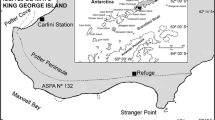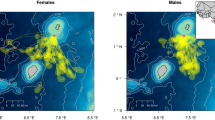Abstract.
Male southern elephant seals (Mirounga leonina) are the largest of the pinnipeds and their foraging migrations take them from their breeding sites to Antarctica where some remain to moult. During February and March 2000, we stomach lavaged 23 male elephant seals that had migrated to a moult location in the Windmill Islands (66°30′S, 110°30′E) on the Antarctic coast. In the 8 stomachs that contained prey remains, we found beaks from 2 squid species (Alluroteuthis antarcticus, n=2, and Psychroteuthis glacialis, n=9), remains of 1 unidentified benthic fish species, 16 specimens of Euphausia crystallorophias and 1 mysid species. This is in contrast to the maximum of 17 squid and 4 fish taxa identified from stomachs sampled at Heard and Macquarie Islands, and the 7 squid taxa identified from seals at King George Island in the South Shetland Islands. Elephant seals appear to be a seasonally important component of the Antarctic marine ecosystem. "Antarctic" squid species, such as P. glacialis, may constitute the most important cephalopod prey for southern elephant seals that forage at high latitudes of the Southern Ocean. If the commercial potential for P. glacialis is realised, there is also potential for competition between the fishery and the seals.
Similar content being viewed by others
Author information
Authors and Affiliations
Additional information
Electronic Publication
Rights and permissions
About this article
Cite this article
van den Hoff, J., Burton, H. & Davies, R. Diet of male southern elephant seals (Mirounga leonina L.) hauled out at Vincennes Bay, East Antarctica. Polar Biol 26, 27–31 (2003). https://doi.org/10.1007/s00300-002-0447-y
Received:
Accepted:
Issue Date:
DOI: https://doi.org/10.1007/s00300-002-0447-y




